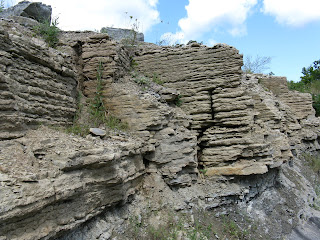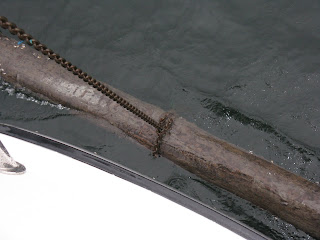
Leland Municipal Harbor was undergoing rebuilding. Michigan has invested in a series of Harbors of Refuge down the coast to provide spots for boaters to get off the lake in case of severe weather and large waves. Money to provide these facilities come from boat license fees and fuel taxes.

Years ago Leland was a busy fishing port. Fish shacks lined the Leland River leading out into Lake Michigan. Now most commercial fishing has died out and the fish shacks have turned into boutiques for tourists. A typical fishing boat is one with high sides and a covered cockpit.

As we walked around Leland there was a park with a garden and a center circle. The center circle was sponsored by a local group called the Leelanau Conservancy which had sponsor plaques all around the circle. It seemed similar to the use of brick for contributions, instead they used specially made glazed plaques with individual designs and the contributors names on them.

How do the boys in Fishtown pick up their girl friends for a date? Well in a Amphicar of course! That way you can cruise the lake or make the "drag" in town.
We were surprised to see this "car" come cruising into the Leland. I think it just motors up the boat ramp onto land and drives off.

We ended August 27 at Leland with calm waters and a pretty sunset.

There is a huge variety of lighthouses on Lake Michigan. This one was attached to what looks like a barn.

We are now into the sand hills of Michigan. Almost all the west coast of Michigan will look like these sand dunes. This picture may have been the Sleeping Bear Dunes National Lakeshore.

Next stop was the Municipal Dock in Manistee. The town has about 6,500 residents. The downtown had an interesting museum of Manistee history with many artifacts for previous centuries. The downtown buildings were interesting. James Earl Jones first began acting at the Ramsdell Theater in Manistee. Manistee was originally important for its logging and salt production industry. Logging has stopped but there are still three factories on Lake Manistee, including Morton Salt.

There was a Glik's store for shopping for clothes and a grocery store near. We were disappointed that the tourist trolley that we walked to does not run on Saturday.
Also at the Manistee Municipal Marina were the New Zealand family, the Ashbeys on the trawler Pearl. We invited them over for snacks and spent several hours finding out about their previous boating adventures in canal boats in England and Europe, the home schooling, and their Great Loop adventure.
We were tied up on a wall downtown the Manistee River. The river is the inlet to Lake Manistee and freighters come up the river to drop off or pick up loads at the salt factories. This freighter passed within 80 feet of our boat as the captain threaded the needle up the river. Later that night he returned going out but was about 8 feet higher in the water indicating they had dropped off a load of some bulk material.



We spent one night anchored in Lake Muskegon and dinghyed into a marina to catch the tourist trolley. We also saw the American Tug 41 Emerald Lady of our friends Dick and Nancy White tied up at the marina while they were away in Kentucky. The trolley tour showed us that there were many attractions to visit in Muskegon.

As we were leaving the Lake Muskegon inlet we were followed by the catamaran ferry Lake Express starting a high speed trip across the lake to Milwaukee.

We stayed two nights at the Grand Haven Municipal Marina. We walked to the Train Station museum and learned about a fountain, sound, and light show that happened every night of the summer through Labor Day. We sat on the back cockpit of our boat both nights and were able to hear and watch the fountains across the river move up down and around in time to music as colored lights played on the water. It was a great show.

The next day we rented a car at Grand Haven, bought groceries at WalMart and headed off to Muskegon. A quick stop for Barbecue Ribs and pulled pork at Mr. T's Barbecue in Muskegon gave us strength for touring. Next stop was the Great Lakes Naval Memorial and Museum. The museum displayed information mostly about submarines, because outside was the WWII sub Silversides credited with sinking 23 Japanese ships, the third most of any US Sub, and the only one of the three still preserved.

The tour through the sub was interesting. This particular galley table is famous because an emergency appendectomy was preformed by Pharmacists Mate (similar to a Navy Corpsman) Thomas Moore. With no experience in surgery other than observing some Moore removed the appendix of sailor George Platter using some tools fashioned from kitchen ware and saved his life. This event was depicted in the movie Destination Tokyo.
 Next was one of two remaining LST's from WWII. This Landing Ship Tank (LST) was involved in several landing in Europe including Salerno and Normandy.
Next was one of two remaining LST's from WWII. This Landing Ship Tank (LST) was involved in several landing in Europe including Salerno and Normandy.
The huge bow doors open to reveal a large area for storing vehicles to be deposited on the enemy beach. Crew and army quarters were near the stern of the boat. It is one of the few boats with an anchor on the stern (used to pull the boat back off the beach.)

The tour through the sub was interesting. This particular galley table is famous because an emergency appendectomy was preformed by Pharmacists Mate (similar to a Navy Corpsman) Thomas Moore. With no experience in surgery other than observing some Moore removed the appendix of sailor George Platter using some tools fashioned from kitchen ware and saved his life. This event was depicted in the movie Destination Tokyo.
 Next was one of two remaining LST's from WWII. This Landing Ship Tank (LST) was involved in several landing in Europe including Salerno and Normandy.
Next was one of two remaining LST's from WWII. This Landing Ship Tank (LST) was involved in several landing in Europe including Salerno and Normandy.The huge bow doors open to reveal a large area for storing vehicles to be deposited on the enemy beach. Crew and army quarters were near the stern of the boat. It is one of the few boats with an anchor on the stern (used to pull the boat back off the beach.)


































